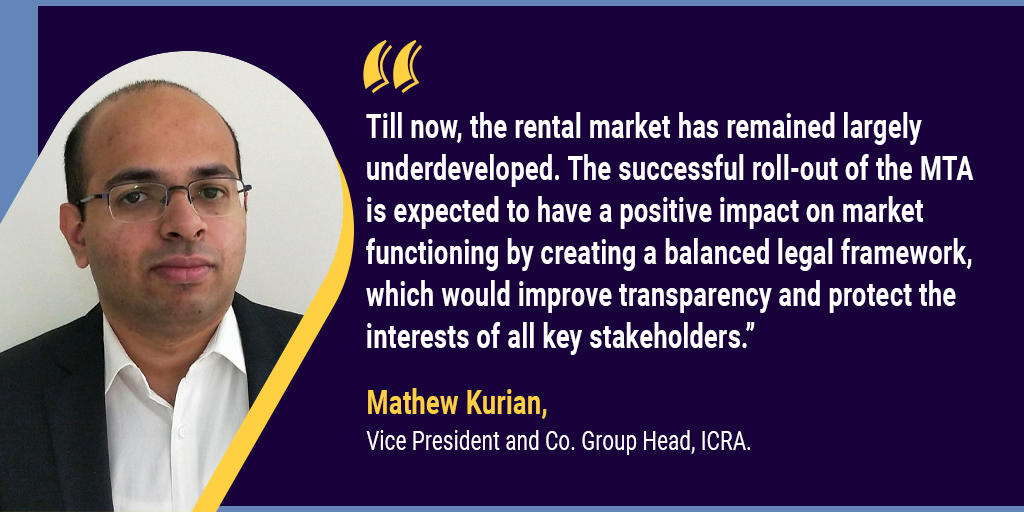“India’s rental market is poised for a significant change and development post the approval of the Model Tenancy Act (MTA) by the Union Cabinet. The new Act aims at bringing about a balance of interests between tenants and landlords,” said Mathew Kurian, Vice President and Co. Group Head, ICRA.
In an exclusive interview with RoofandFloor, he spoke about India’s residential real estate market, MTA, Pradhan Mantri Awas Yojana, and much more.
Here are the excerpts.
How is India’s residential real estate market positioned currently?
Covid-19 had triggered one of the worst demand crashes in recorded history, with housing sales witnessing a Y-o-Y decline of 62% during Q2 of CY2020 (corresponding to the national lockdown in the first wave) across the top eight Indian cities. However, recovery from the same was quick, and by Q1 of CY2021, sales across the top eight cities neared 85 million square feet (msf), reflecting amongst the highest level of sales over the last twenty quarters.
The growth was fundamentally driven by an increased focus on homeownership and betterment, given the elongation in work-from-home requirements. Improved affordability, arising from low home loan rates, attractive payment/discount schemes, and stamp duty reductions in certain key states, acted as an enabler.
The second wave of the pandemic resulted in a sequential decline of around 19% in Q2 of CY2021 from the peaks of Q1, thereby derailing the strong demand recovery witnessed post the first wave. Notably, the impact of the second wave was not as severe as that of the first. Going forward, demand drivers such as low home loan rates and income tax sops, particularly for affordable housing, are expected to support recovery.
Other cities, such as Hyderabad and Chennai also recorded a fast pace of recovery, on the back of continued commercial real estate activity, which, in turn, supported residential demand.
The cabinet approved the Draft Model Tenancy Act, 2019 recently. How will the Act benefit homeowners and tenants?
India’s rental market is poised for a significant change and development, post the approval of the Model Tenancy Act (MTA) by the Union Cabinet. The new Act aims at bringing about a balance of interests between tenants and landlords. It specifically attempts to address some of the main conflicting issues between the parties by establishing a rent authority. Moreover, it clarifies the premise and process for eviction of tenants, maximum level of security deposit, and rent revision.
With such measures, the successful roll-out of the MTA is expected to have a positive impact on market functioning by creating a balanced legal framework, which would improve transparency and protect the interests of all key stakeholders.

Till now, the rental market has remained largely underdeveloped, despite the presence of vacant units in urban areas. This is primarily due to trust issues between landlords and tenants, low rental yields, and lengthy dispute resolution mechanisms.
With the MTA, housing stock can be used more efficiently, which would support the institutionalisation of the sector over the medium-to-long term. The consequent development of new business models would aid improvement in return metrics.
However, effective and broad-based implementation of the Act along with continued government support and initiatives would remain the key.
Over the last year, the government announced various measures to boost consumer sentiment. Do you think there’s more scope from the government’s side?
Government measures played an important role in supporting the recovery seen post the first wave. While the essential underlying demand drivers of homeownership were reinforced by the pandemic, measures such as stamp duty reductions and continued income tax benefits provided key support elements in the short run.
However, in the medium term, the extent of the pandemic impact on income levels and jobs will be a major determinant of housing demand. Thus far, the pandemic has not had a big impact on white-collar jobs, and thus, demand for urban housing was able to recover quickly post the first wave.
Going forward, the medium-long-term trend in jobs and income levels would remain a key look-out area. Local and central government initiatives on improving urban infrastructure and enabling planned expansion of the city limits would also be important for the industry.
According to your recent report, the actual implementation of PMAY has fallen below scheduled targets. What, according to you, can help in achieving the ambitious Housing for All by 2022 mission?
ICRA believes that the ramp-up will be required for the financial as well as physical progress. In terms of funding, out of the required Rs 4.70 Lakh Crore funding (aggregate for urban and rural schemes), Rs 2.97 Lakh Crore has been incurred in the last five years but Rs 1.71 Lakh Crore (~37%) of the expenditure would be required to be incurred within the next 1.5 years to complete the construction of the balance units by 2022 to meet the near-term scaled-down target.
However, in terms of expenditure trend, the actual consolidated expenditure on PMAY in FY2020 was Rs 25,000 Crore, the RE stood for FY2021 was Rs 40,500 Crore, while the aggregate budgetary allocation for FY2022 is only Rs 47,500 Crore (including budgeted EBR). Thus, a large gap of Rs 1.24 Lakh Crore is required to be plugged in the next 1.5 years to meet the near-term target.
In terms of execution, the annual execution pace has been 4.6 million units, while the requirement is to complete the remaining 13.6 million units by the end of 2022.
While Covid related disruptions may create delays in the completion of sanctioned housing under the scheme, a ramp-up in budgetary allocations to meet the sanctioned financial assistance will be a key determinant of the ability to achieve the goals.
What will drive housing demand in the country in H2 2021?
The housing demand is expected to recover to similar levels as witnessed in H2 of CY2020 (around 114 msf in the top eight cities).
While the possibility of subsequent waves and further income shocks will weigh on homebuyers, the fundamental demand drivers will be augmented by factors such as consumers’ desire for higher quality homes, stability witnessed in the income profile of salaried employees in IT and related sectors, and improved affordability. The larger real estate developers with established brands will be well placed to capture this demand and gain a higher market share within the overall real estate market.

